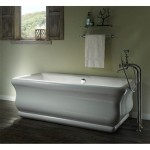Can You Paint a Plastic Bathtub Surround?
Painting a plastic bathtub surround can be a cost-effective way to refresh your bathroom's appearance without the expense of a complete renovation. While it may seem like a simple task, there are several factors to consider before embarking on this project. The success of painting a plastic bathtub surround depends heavily on the type of plastic used, the condition of the existing surface, and the careful application of the right paint products.
Understanding Plastic Surfaces
Not all plastics are created equal. Some plastics are more receptive to paint than others. Acrylic, ABS, and PVC are common materials used in bathtub surrounds. Acrylic is generally the most readily paintable material, while PVC can be more challenging due to its slick, non-porous surface. ABS is often a good option for painting, but it's essential to ensure proper preparation to achieve a lasting finish. Before you start painting, it's crucial to identify the type of plastic used in your bathtub surround to determine the best approach.
Preparing the Surface for Painting
Proper surface preparation is the key to a successful paint job on any surface, and plastic is no exception. Here are some essential steps to ensure a smooth, durable, and long-lasting finish:
- Clean Thoroughly: Start by cleaning the bathtub surround with a mild detergent and water. Remove any dirt, soap scum, or mold. Rinse thoroughly to remove any residue.
- Sand for Adhesion: Sanding the surface creates a rough texture that helps the paint adhere better. Use fine-grit sandpaper, starting with 220 grit and progressing to 400 grit for a smoother finish.
- Prime for Protection: Apply a specialized primer specifically designed for plastic surfaces. This primer will ensure better adhesion and create a barrier between the plastic and the paint.
- Address Any Imperfections: If the surround has cracks or chips, you can use a plastic-compatible patching compound to fill them in before sanding and priming the surface.
Selecting the Right Paint
Choosing the right paint is critical for a long-lasting and attractive finish. Consider the following factors:
- Adhesion: Look for paint specifically designed for plastic surfaces. These paints have additives that help them bond effectively to the plastic material. Seek out formulations labeled as “acrylic latex” or “alkyd enamel” for excellent adhesion.
- Durability: Bathroom environments are prone to moisture and humidity. Choose a paint that offers good moisture resistance and is mildew-resistant. Look for formulations marked as “bathroom paint” or “kitchen and bath paint” for optimal performance.
- Finish: The paint finish you choose will affect the overall look of your bathtub surround. Consider a semi-gloss or gloss finish for a more durable and easily cleaned surface. A flat or matte finish will provide a more subtle appearance.
Applying the Paint
Once you have prepared the surface and chosen the appropriate paint, you can start painting. Take your time and follow these steps:
- Start with a Thin Coat: Apply the first coat of paint in thin, even strokes, ensuring to cover the entire surface. Avoid overloading the brush or roller, which can cause drips or runs.
- Allow for Drying Time: Let the first coat dry completely before applying the second coat. Follow the drying times specified on the paint can for optimal results.
- Apply Additional Coats: For a more opaque and robust finish, apply two or three coats of paint, allowing for adequate drying time between each coat.
Important Considerations
Painting a plastic bathtub surround can be a worthwhile project, but several factors can determine its success. Consider these important considerations:
- Professional Help: If you are unsure about the type of plastic used or feel apprehensive about handling paint, it's wise to seek professional help. A professional painter can assess the situation and provide expert advice and service.
- Alternative Solutions: If the surface is significantly damaged or the type of plastic is unsuitable for painting, you may consider alternative solutions such as replacing the surround, using wall tiles, or applying a decorative film.
- Proper Maintenance: After painting, it's essential to maintain the surface to preserve its look and longevity. Avoid using harsh cleaning chemicals, and use gentle cleaning agents specifically designed for painted surfaces.
Painting a plastic bathtub surround can be a successful project, but it requires proper preparation, the right paint, and careful application. By following these tips, you can achieve a fresh and updated look for your bathroom while staying within budget.

How To Paint A Bathtub Yourself The Nifty Nester

Diy Painted Bathtub Follow Up Your Questions Answered Addicted 2 Decorating

How To Refinish Your Bathtub For 50

How To Paint A Tub Shower Surround Before After Fiberglass Refinishing Diy Power Couple

Bathroom Makeover Day 11 How To Paint A Bathtub Addicted 2 Decorating

Refinishing Plastic Tub Surround Without Ripping Out The Whole Thing Bathtub Remodel Shower

How We Painted Our Old Yellow Fiberglass Bathtub To Make It Look Brand New For 50 Shower Remodel Bathrooms Bathroom Design

Can Plastic Acrylic Or Fiberglass Bathtubs Shower Stalls Be Reglazed Refinished America Refinishing Pros

Yes You Can Paint Your Bathtub And Tile Here S How Toolbox Divas

Painting A Plastic Fibreglass Tub And Surround Using Marine Paint








